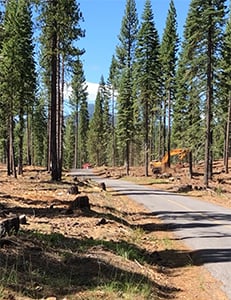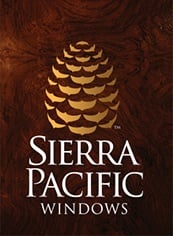
During the Fire | Foresters & Firefighters
Sierra Pacific actively works to create community awareness through our neighbors, conservation agencies, and firefighters. On high fire danger days, we curtail our woods operations. This year, we closed our forestlands to public access on June 21st, more than two months earlier than last year. “SPI takes its commitment to protecting our forest resources and public safety seriously,” said Andrea Howell, SPI spokesman. “With this year’s extreme drought conditions having substantially increased the risk of wildfire, we have made the difficult decision to close our lands to public access and recreation.” Two weeks later, we closed SPI forestlands in southern Washington.

Our crews and contractors working in the woods are trained on the use of firefighting equipment, they monitor the weather daily and have patrols to help ensure accidental fire starts do not occur. We fund and maintain a private road system that is mapped and accessible for fire-fighting agencies. During a wildfire our foresters are in direct communication with firefighting agencies, sharing our road maps and fuel break areas to give the firefighters additional help to know where they could give bulldozers access to work the lines. If you think about what an unmanaged forest might look like, with no roads or access, unknown terrain, very thick trees, and undergrowth, it makes it nearly impossible for firefighters to fight the battle on the ground. But, by having roads and fuel breaks, they can get their equipment in, set up an area to work from, and sometimes use it as a control or fire line. Because of how Sierra Pacific manages our land, we build and maintain roads and bridges and have maps of where all of these accessible areas are. When there is a fire near or on SPI land, our foresters are in direct contact with the fire crews, sharing that information, giving those firefighters an advantage.
Because of the size of the Dixie fire, and seeing the assumed path it might take, it gave firefighters and communities time to do some proactive work. In an effort to better protect some of the smaller communities, firefighters cleared trees and mowed brush in the expected path of the fire – things that are done regularly in a managed forest. On the Dixie fire, SPI owns land directly adjacent to the community of Chester, CA. As part of our management practices, a shaded fuel break was installed just north of the community in which the trees were thinned to a wide spacing and the understory removed to create a more fire-resistant area. During fire suppression activities Cal Fire utilized this SPI fuel break to conduct a strategic backfire operation to stop the fire from spreading into the community of Chester. This is one of many examples of proper forest management assisting fire crews in their efforts to contain and control these large fires.
We visited again with one of Sierra Pacific Industries’ California Registered Professional Foresters, Eric Wertz. We asked Eric what our foresters do during a wildfire.
This seems to be everchanging as time progresses and fires become more common. Several years ago, our primary duties during a wildfire would have been to provide information to firefighting agencies about terrain and ground conditions that were conducive to equipment, fire line construction, road locations, water sources and simply providing them with better maps and helping them to quickly locate the fires. However, the past couple of years this has transitioned to a more involved process where foresters are more actively engaged with the firefighters giving them information about ground conditions but also working with their dozer operators, hand crews, and in some cases helping fire crews mark fire lines. When several large fires are actively burning, fire resources can be incredibly limited and SPI foresters can provide fire crews with valuable information or on the ground assistance to help them more aggressively and safely fight these fires.
Fire Suppression
Proper forest management that increases overall forest health can decrease the likelihood of damage from catastrophic fire. Forest managers are experts in practices such as selective harvesting, thinning treatments, prescribed burning, or brush removal to counteract the cumulative impact of years of fire suppression activity. Controlled burns, or prescribed fires, intentionally reduce forest debris to effectively reduce the risk of catastrophic fires and related side effects such as unhealthy air.

One of the most important components of wildfire suppression are control lines, or boundaries that firefighters employ to control the spread of the fire. A river can serve as a natural control line, or firefighters can establish a manmade one by removing all vegetation up to an existing barrier. When you hear on the news that a fire is “X percent contained,” this is generally what they’re talking about, that some percentage of the fire’s perimeter has a control or fire line.
A Little History
It’s counterintuitive, but the history of suppressing wildfire in the United States has actually made present-day wildfires worse. Concern for protecting commercial timber supplies and watersheds helped conservationists convince the U.S. government in 1891 to begin setting aside national forest reservations. When the U.S. Forest Service was established in 1905, it was given managerial control of these lands, soon renamed national forests. Forest management necessitated fire protection. Five years later, during the “Big Blowup,” a series of forest fires burned 3 million acres in Montana, Idaho, and Washington in only two days. The 1910 fires had a profound effect on national fire policy. Local and national Forest Service administrators emerged from the incident convinced that the devastation could have been prevented if only they had had enough men and equipment on hand. They convinced themselves and members of Congress and the public, that only total fire suppression could prevent such an event from occurring again. A policy of total fire suppression was instituted, with only two goals: preventing fires and suppressing a fire as quickly as possible once one started. It should be remembered that at this time foresters had a limited understanding of the ecological role of fire. Fast forward to the early 1970s with a radical change in Forest Service policy, to let fires burn when and where appropriate.
Fires Can Create Their Own Weather
Add climate change, years of drought, and the high level of fuel in unmanaged forests, we are seeing more frequent and larger wildfires. Fires burn hotter, move faster, and can even create their own weather in some cases. The Carr Fire in Redding (2018) and the Bootleg Fire in Oregon (2021) both created their own weather. During a June 2021 fire in northern California, a fire tornado took form. A fire tornado is a swirl of smoke and fire that can only exist under extreme dry conditions. The fire takes the shape of a vortex, moving further into the skies. This is a rare occurrence but has been seen a few times now. Sometimes, wildfires can create “a perfect storm” of weather, including pyrocumulus clouds, lightning and even fire tornadoes. I saw one of these pyrocumulonimbus clouds while flying home during the Bootleg Fire. These are massive anvil-shaped cloud clusters reaching miles into the sky, actually created by the smoke and heat from a wildfire. Most of the state’s largest wildfires have happened in the last 10 years. The last two years have broken records for death and destruction.
Update
Since its ignition, the Dixie Fire has consumed more than 950,000 acres, an area larger than New York City, Chicago, Dallas, and Los Angeles combined. It was the first blaze in state history to burn from one side of the Sierra Nevada mountain range to the other and has now burned in five separate counties (Butte, Plumas, Lassen, Tehama, Shasta). The wildfire is now 86% contained but has destroyed more than 1300 structures, according to the California Department of Forestry and Fire Protection. The cause of the fire remains under investigation.

Thank you for reading our blog, and getting to know more about Sierra Pacific Industries. We are looking forward to sharing the third and final part of this blog series: After the Fire. Find out what sets a sustainably managed forest apart from the rest, from harvesting the burn sites to replanting for the future. Watch for Part Three in about two weeks!
Additional Resources
- “U.S. Forest Service Fire Suppression” Forest History Society
- “10 Strategies Firefighters Use to Fight Wildfires” Brook Hays July 31, 2018, MentalFloss.com
- “Addressing wildfire through forest management” Paul Trianosky January 4, 2020, greenbiz.com Sponsored by SFI
Photo & Video credits and information: photo 1 Smoke cloud taken by Eric Wertz, Sierra Pacific Industries Professional Forester, photo 2 Fuel break. Photo taken by Eric Wertz, Sierra Pacific Industries Professional Forester, photo 3 Crewmembers prepare fuel break on SPI land, photo 5 Cal Fire active fire map (9/16/21)


